PEP小学英语小升初语法
小升初英语必背短语(知识清单)-人教PEP版英语六年级下册
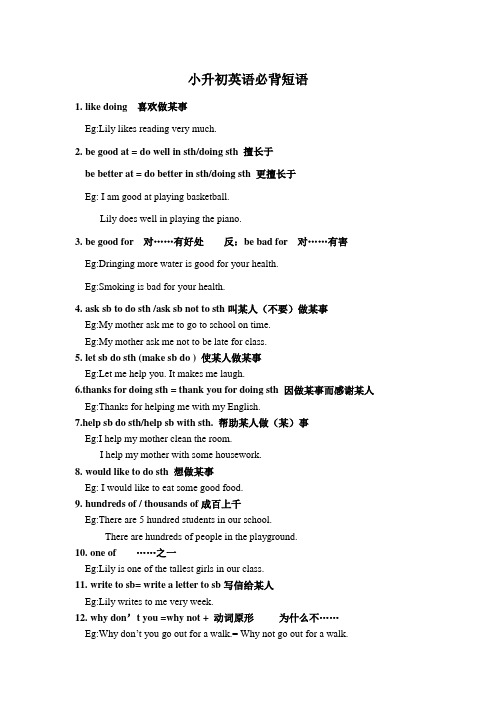
小升初英语必背短语1.like doing 喜欢做某事Eg:Lily likes reading very much.2.be good at = do well in sth/doing sth 擅长于be better at = do better in sth/doing sth 更擅长于Eg: I am good at playing basketball.Lily does well in playing the piano.3.be good for 对……有好处反:be bad for 对……有害Eg:Dringing more water is good for your health.Eg:Smoking is bad for your health.4.ask sb to do sth /ask sb not to sth叫某人(不要)做某事Eg:My mother ask me to go to school on time.Eg:My mother ask me not to be late for class.5.let sb do sth (make sb do ) 使某人做某事Eg:Let me help you. It makes me laugh.6.thanks for doing sth = thank you for doing sth 因做某事而感谢某人Eg:Thanks for helping me with my English.7.help sb do sth/help sb with sth. 帮助某人做(某)事Eg:I help my mother clean the room.I help my mother with some housework.8.would like to do sth 想做某事Eg: I would like to eat some good food.9.hundreds of / thousands of成百上千Eg:There are 5 hundred students in our school.There are hundreds of people in the playground.10.one of ……之一Eg:Lily is one of the tallest girls in our class.11.write to sb= write a letter to sb写信给某人Eg:Lily writes to me very week.12.why don’t you =why not + 动词原形为什么不……Eg:Why don’t you go out for a walk.= Why not go out for a walk.13.something important 一些重要的事情不定代词+形容词14.it’s time to do sth= it’s time for sth.是时候做某事了Eg:It’s time to have lunch.= It’s time for lunch.15.be like问性格,look like 问外貌be like 范围更大一些,有时候既问性格也问外貌Eg:What's your sister like? 你姐姐怎么样?/你姐姐是怎样一个人?She is kind. 她很善良。
PEP小升初语法、常用句型总复习

15.--- A:Whose coat is this? ---B:It’s mine.
16.--- A:Who’s your art teacher?(你的美术老师是谁?)---B: Mr Jones.
---B:Sure.Here you are.(当然可以,给你。)
22.---A:What can you do for the party, children?(孩子们,你们能为联欢会做什么?)
----B:I cansing English songs. (我会唱英文歌。)
23.---A: Can you do any kung fu, John? (约翰,你会武术吗?)
---A: I’m angry. What should I do?
---B:You should take a deep breath.
36.---A: How tall are you?你有多高?
--- B:I’m 1.65 metres.我1.65米高。
37. ---A: How heavy are you?你有多重?
3.动词的现在进行时(ing):climbing (正在)攀登eating(正在)吃playing(正在)玩耍jumping(正在)跳drinking(正在)喝(水)sleeping (正在)睡觉doing morning exercises (正在)做早操have…class (正在)上。。。课eating lunch (正在)吃午饭reading a book (正在)看书listening to music (正在)听音乐
小升初英语语法现在进行时(讲义)人教PEP版英语六年级下册

2024年小升初英语语法精讲精练第四章现在进行时一、定义:【考点精讲】定义:表示说话时或现阶段正在进行的动作。
【实战演练】判断下列句子是(T)否(F)为写作进行时。
( )1. She eats an apple everyday.( )2. They are playing football on the playground now.( )3. There is some water on the floor.( )4. The dog is running after a cat.( )5. The Greens are having lunch now.二、现在进行时的基本结构:【考点精讲】总结:结构:主+am/ is/are+现在分词(V+ing).1.肯定:He _________ _________ (do) homework.否定:He _________ _________ (do) homework.Yes/No Question:— _________ he _________ homework?—Yes, he _________ ./No, he _________ .Wh/How Question:—What _________ he _________ ?2.肯定:We _________ _________ (do) homework.否定:We _________ _________ (do) homework.Yes/No Question:— _________ you _________ homework?—Yes, we _________ ./No, we _________ .Wh/How Question:—What _________ you _________ ?【实战演练】用括号中动词的适当形式填空:1.My parents _________ (watch)TV now.2.Look.!Three boys _________ (run).3.What _________ your mother _________ (do) now?4. _________ your dog _________ now?(sleep)5. _________ you _________ (listen) to music?Yes,I am.三、词形变化(现在分词):【考点精讲】总结:⑴ 直接+ing watching looking⑴ 去e+ing giving making ing⑴ 双写最后一个字母+ing sitting putting running⑴ 以ie结尾变ie为y加ing lielying diedying tietying【实战演练】写出下列动词的现在分词go _________ listen _________ play _________ e _________ sing _________ have _________ write _________ dance _________ sit _________ read _________ 四、现在进行时的基本用法【考点精讲】⑴ 表示说话时正在进行的动作,常和now, look, listen 连用。
PEP英语小升初知识点归纳

PEP英语小升初知识点归纳(一)短语和词组line up 排列 a long tail 一条长尾巴than you taller 比你高how heavy 多重how long多长how big 多大have a fever 发烧have the flu 患流感a big nose 一个大鼻子have a headache 头痛go to the park 去公园watch TV看电视at night 在夜晚play the piano 弹钢琴play football 踢足球listen to music听音乐go swimming 去游泳wash clothes 洗衣服feel tired 感觉劳累take some medicine 吃药worry about 焦急,担心have a sore throat 喉咙疼have a toothache 牙痛laugh at 因…而发笑eat good food 品尝美食buy present 买礼物take pictures 照相learn Chinese 学汉语folk dance 民族舞folk clothes 民族服装this weekend 这个周末by plane (by air)乘飞机 a taxi driver 出租车司机go skiing去滑雪far from 离….远farewell party欢送会last day of the holiday 假期的最后一天good luck 好运at the museum/airport 在博物馆/飞机场in the future 在将来the end of the school 学年末carrot juice 胡萝卜汁 a book of stamps 一本邮册just a minute 等一会Stone forest 石林Spring city 春城on the moon 在月球funny tongue twisters 有趣的绕口令a few days 几天the deep cold water 在寒冷的深水a pair of 一双theme park 主题公园read a magazine 阅读杂志comic book 漫画书fruit stand 水果摊shoe store鞋店pet shop 宠物商店go to the cinema 去看电影go away 离开go back to school 返回学校go hiking 远足go on a big trip 进行一次长途旅行answer the door 开门answer the phone 接电话answer----answering(现在分词)take off 脱下take a trip 去旅行take---took (过去式) taking(现在分词) takes(单三)do the dishes洗碗碟do morning exercises 晨练do an experiment 做实验did(过去式)do housework 做家务do homework 做作业do—does (单三) doing (现在分词)write a report 写报告write a letter 写信write an e-mail 写电子邮件write a poem 写诗write (writes 单三)(writing现在分词)(wrote 过去式)make a snowman 堆雪人make a kite(make kites) 制作风筝make the bed 整理床铺collect insects 收集昆虫collect stamps 收集邮票collect leaves 收集树叶make sure 确认cook the meals 做饭cook noodles 煮面条catch the ball 接球catch butterflies 捉蝴蝶catch—caught(过去式) catches(单三)交通用语stop at a red light 红灯停wait a yellow light 黄灯等go at a green light 绿灯行by bike 骑自行车on foot 步行by car(take the car)/by subway/ by ship crosswalk人行穿越道No entry禁止通行No bikes自行车禁行One way单行道Turn right 右转No turn left 禁止左转告别语write soon尽快给我回信take care保重have a trip 旅途愉快keep up touch 保持联系see you later 一会见(二)词的用法A.名词复数例:book---books watch—watches baby---babies knife---knives roof--roofs foot---feet man—men goose—geese ox--oxen child—children mouse---mice tomato—tomatoes fish—fish deer—deer Chinese –Chinese Japanese—Japanese woman doctor-----women doctorsB.冠词例:a worker a pen an hour an apple an orange the pictureC.代词例:I(主格)---me(宾格)my(形容词物主代词)-----mine(名词性物主代词) You ----you your ---- yoursHe -----him his ------ hisShe ----her her ------hersWe ---us our ------oursYou ---you your ------yoursThey -- them their -------theirs(注:This is my jacket.(同义句) This jacket is mine.D.数词.基数词one two three four …..序数词first second third fourth fifth eighth ninth twentieth thirty—first(第三十一)F.形容词比较级和最高级例:tall—taller big---bigger heavy—heavier late—later beautiful—more beautiful good/well---better---best(最高级) many/much---more---most(最高级)ill/bad----worse-----worst(最高级) little-------less---------least(最高级)old---older/elder—oldest/eldest(最高级) far—farther/further—farthest/furthest(最高级) 例句:I am taller than your brother. He is shorter than me.(三)英语时态的简单用法A..一般现在时(当主语是单数第三人称时,谓语动词要发生相应的变化,即单三形式)(always usually often sometimes never every day …..这些词出现体现一般现在时)例1.)He always helps others. 他总是帮助别人。
PEP小学英语小升初必考知识点归纳

PEP小学英语小升初必考知识点归纳择校季即将来临,对于即将从小学升入初中的孩子们来说,英语成绩自然成为了重要的评判标准之一。
为了帮助孩子们备战英语考试,本文将归纳PEP小学英语小升初必考的知识点,以便孩子们做针对性的复习和提高。
1. 词汇与拼写1.1 基础单词:掌握常见的英语词汇,包括数字、颜色、家庭、学校、动物、水果等。
1.2 时态动词:掌握一般现在时、一般过去时、一般将来时的动词变化规则。
1.3 拼写:熟练掌握常见单词的拼写,注意特殊单词的正确拼写,如weather、restaurant等。
2. 语法知识2.1 代词:掌握人称代词(I、you、he/she等)和物主代词(my、your、his/her等)的用法。
2.2 名词单复数:了解名词单复数的变化规则,并能正确运用于句子中。
2.3 冠词:熟悉不定冠词(a、an)和定冠词(the)的用法。
2.4 形容词:学会形容词的用法,以及形容词的比较级和最高级形式。
2.5 介词:掌握常用介词的用法,如in、on、at等。
2.6 动词词组:掌握一些常用的动词词组,如look after、take care of 等。
3. 句型与表达3.1 Be动词句型:掌握“主语+be动词+形容词/名词”句型的用法,如I am happy、He is a teacher等。
3.2 疑问句:学会用be动词和助动词构成疑问句,如Are you a student?、Can you swim?等。
3.3 祈使句:了解祈使句的基本结构,如Wash your hands before eating.等。
3.4 感叹句:了解感叹句的表达方式,如How beautiful!、What anice day!等。
3.5 日常交际用语:熟练掌握日常用语,如问候语、道谢、道歉等。
4. 阅读理解4.1 短文阅读:学会从短文中获取信息,并正确回答问题。
4.2 图片阅读:学会看图并理解其含义,回答相关问题。
小升初英语语法介词(讲义)人教PEP版英语六年级下册

2024年小升初英语语法精讲精练第八章介词【考点精讲】1.in+语言/颜色/衣帽等,表示使用某种语言或穿着……。
eg. in English, in Chinese, She is in red.2.in + Row/ Team/ Class/ Grade等,表示“在……排/组/班级/年级”等。
eg. in Row Three. He is in Class Five, Grade Seven.3.in the morning在上午/in the afternoon在下午/ in the evening 在傍晚4.in the desk/ pencilbox/bedroom 等表示“在书桌/铅笔盒/卧室里”。
5.in the tree“在树上(非树本身所有)” the cat / kite in the treeon the tree“在树上(为树本身所有)” the apples / leaves on the tree6.in the wall表示“在墙上(凹陷进去)” the window /door in the wallon the wall表示“在墙上(指墙的表面)” the picture on the wall7.at work(在工作)/at school(上学)/at home(在家)/at noon (在正午)at night(在夜晚)/at Christmas(在圣诞节)应注意此类短语中无the。
8.at + 时刻表示钟点。
at 6:30 / at twelve o’clock9.like this表示方式, “像……这样” ;like that表示方式,意为“像……那样”。
10. of短语表示所属关系。
a friend of mine 我的一个朋友/ a map of China 一幅中国地图11.behind/ beside/ near/ under+ 名词等,表示方位、处所。
人教版(PEP)小学英语小升初时态课件

四、一般过去时 一般过去时表示过去某个时间产生的动作或存在 的状态。 (一)时间状语:last year/week,yesterday,just now
(二)结构 1.肯定句:主语+was/were+其他. I was ill yesterday.昨天我生病了。 否定句:主语+was/were+not+其他. I wasn’t ill yesterday.昨天我没有生病。 一般疑问句:Was/Were+主语+其他?
当主语是第三人称单数时: ①肯定句:主语+动词第三人称单数+其他. She cleans the room every day. 她每天打扫房间。 ②否定句:主语+助动词(doesn’t)+动词原形+其他. She doesn’t clean the room every day. 她不是每天打扫房间。
二、一般现在时 一般现在时是表示经常产生的动作、存在的状态 或习惯性的动作的时态。常用的时间状语有:often, sometimes,usually,in the morning/afternoon/evening, every week/day/year等。
(一)构成 1.表示目前的状态,谓语动词用be动词。 肯定句:主语+be动词+其他.
时态
一、现在进行时 现在进行时表示现在正在进行或产生的动作。 (一)结构:be(am,is,are)动词+现在分词(动词-ing情 势) (二)现在进行时的标志词有now,look,listen等。 I’m playing football now. 我现在正在踢足球。
Look!The girl is reading a book. 看!那个女孩正在看书。 Listen!The bird is singing. 听!小鸟正在唱歌。
PEP小学英语小升初必考知识点归纳
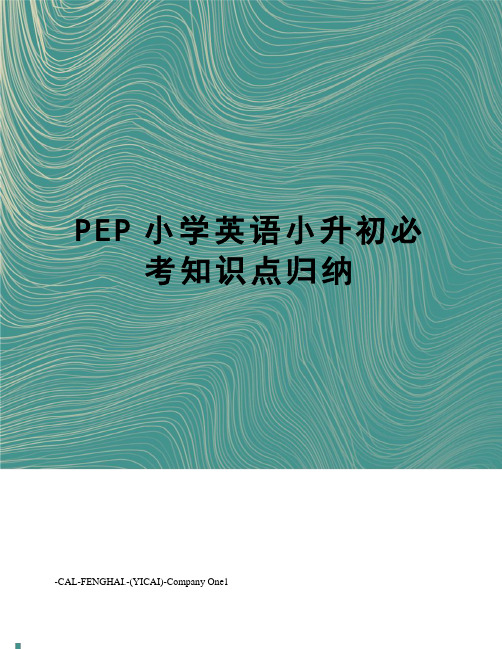
P E P小学英语小升初必考知识点归纳-CAL-FENGHAI.-(YICAI)-Company One1PEP小学英语小升初知识点归纳一:学生易错词汇1. a, an的选择: 元音字母开头的单词用an,辅音字母开头的单词用a.2. am , is , are的选择: 单数用is , 复数用are. I 用 am , you 用 are.3. have , has 的选择: 表示某人有某物。
单数用has , 复数用have. I , you 用 have .4. there is, there are 的选择:表示某地有某物,某人。
单数用there is , 复数用there are.5. some, any 的选择:肯定句用some, 疑问句和否定句用any.6. 疑问词的选择:what (什么) who (谁) where (哪里) whose (谁的) why(为什么)when(什么时候)which(哪一个)how old (多大) how many (多少)how much(多少钱)二:形容词比较级详解当我们需要对事物作出比较时,需要用到比较级。
比较级的句子结构通常是:什么 + 动词be (am , is , are ) + 形容词比较级 + than(比)+ 什么 ,如:I’m taller and heavier than you. (我比你更高和更重。
)An elephant is bigger than a tiger. (一只大象比一只老虎更大。
)形容词的比较级是在形容词的基础上变化而来的,它的变化规则是:① 一般的直接在词尾加er ,如 tall - taller , strong - stronger ,② 以e结尾的,直接加r ,如 fine – finer ,③ 以辅音字母加y结尾的,先改y为i再加er,如funny - funnier④ 双写最后的字母再加er,如big – bigger, thin – thinner ,hot – hotter☆注意比较的两者应该是互相对应的可比较的东西。
PEP小学英语小升初必考知识点归纳
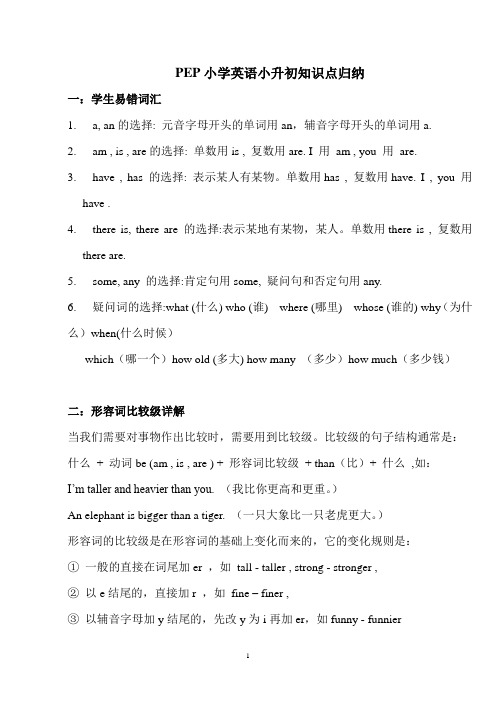
PEP小学英语小升初知识点归纳一:学生易错词汇1. a, an的选择: 元音字母开头的单词用an,辅音字母开头的单词用a.2. am , is , are的选择: 单数用is , 复数用are. I 用am , you 用are.3. have , has 的选择: 表示某人有某物。
单数用has , 复数用have. I , you 用have .4. there is, there are 的选择:表示某地有某物,某人。
单数用there is , 复数用there are.5. some, any 的选择:肯定句用some, 疑问句和否定句用any.6. 疑问词的选择:what (什么) who (谁) where (哪里) whose (谁的) why(为什么)when(什么时候)which(哪一个)how old (多大) how many (多少)how much(多少钱)二:形容词比较级详解当我们需要对事物作出比较时,需要用到比较级。
比较级的句子结构通常是:什么+ 动词be (am , is , are ) + 形容词比较级+ than(比)+ 什么,如:I’m taller and heavier than you. (我比你更高和更重。
)An elephant is bigger than a tiger. (一只大象比一只老虎更大。
)形容词的比较级是在形容词的基础上变化而来的,它的变化规则是:①一般的直接在词尾加er ,如tall - taller , strong - stronger ,②以e结尾的,直接加r ,如fine – finer ,③以辅音字母加y结尾的,先改y为i再加er,如funny - funnier④双写最后的字母再加er,如big – bigger, thin – thinner ,hot – hotter☆注意比较的两者应该是互相对应的可比较的东西。
典型错误:My hair is longer than you.(我的头发比你更长。
六年级小升初英语知识点pep

六年级小升初英语知识点pep 六年级小升初英语考试是许多学生和家长关注的焦点。
为了帮助同学们更好地备考,本文将介绍六年级英语中的一些重要知识点。
以下按照不同的语法和词汇分类来详细介绍,以便于大家更好地理解和记忆。
名词:名词是指人、事物或概念的名称。
在英语中,名词通常有单数和复数两种形式。
复数形式一般在名词后面加-s或-es,但也有一些特殊情况需要记忆。
例如:- 单数名词后面加-s构成复数形式:book-books, pen-pens, dog-dogs等。
- 单数名词后面加-es构成复数形式:box-boxes, watch-watches, brush-brushes等。
- 以y结尾的单词,去y加-ies构成复数形式:baby-babies,party-parties, candy-candies等。
- 以f或fe结尾的名词,变f或fe为v,再加-es构成复数形式:leaf-leaves, knife-knives, thief-thieves等。
动词:动词是指表示行为或状态的词语。
根据时态和语态的不同,动词的形式和用法也会有所不同。
- 一般现在时:用于描述经常发生的动作、现在的状态或真理。
例如:I go to school every day.(我每天去学校。
)- 现在进行时:用于表示现在正在进行的动作。
现在进行时的动词由be动词(am, is, are)和动词的现在分词构成。
例如:He is playing basketball now.(他正在打篮球。
)- 一般过去时:用于过去某个时间发生的动作。
一般过去时的动词通常是在动词原形后面加-ed构成。
例如:We visited the museum yesterday.(昨天我们参观了博物馆。
)- 一般将来时:用于表示将来要发生的动作或事件。
一般将来时的动词前面要加助动词will。
例如:I will study harder next year.(明年我将更加努力学习。
人版(PEP)小升初英语语法讲义副词(含练习+答案)(12页)

课题名称小升初英语语法-第8讲:副词教学目标知识点:副词、副词的比较等级及特殊用法考点: 副词比较级;特殊用法能力:提升知识综合运用能力,提高效率(重难点)方法:讲练结合Step 1 作业检查●课后练习讲评;➢词汇听写:得分_____________首字母填空练习。
1. Walk a_______ this street and turn left at the third crossing.2. In China the hottest month is A________.3. Have you got an e-mail a_______?4. I don’t want this coat. Please show me a______ one.5. There are many a_________ in the zoo.6. He doesn’t study hard. His father is always a______ with him.7. An a________ a day keeps the doctor away.8. What are you going to do this a_________?9. –What’s your a______?—I’m 14.10. She a________ gets to school early. She’s never late for school. answers: 1. along 2. August 3. address 4. another 5. animals6. angry7. apple8. afternoon9. age 10. always➢知识点回顾;完成句子,根据汉语写英语。
1. 你最好把盘子碟子洗了。
_____________ _____________ ____________ the dishes.2. 服下这些药,你就会感觉好起来了。
小升初语法讲解介词(方位介词)专题训练(讲义)人教PEP版英语六年级下册

小升初语法讲解 介词(方位介词) 专题训练(讲义)人教PEP 版 英语六年级下册知识点讲解方位介词本课我们重点学习几组容易混淆的地点介词。
1. on, over, above两者都表示“在...上面”,介词on 的两者有接触; over 表示“在...正上方”,两者不接触,强调垂直上方; above 指“在……之上”指相对高度,不一定是正上方,其反义词是below 。
The apple is on the table. 苹果在桌子上。
The lamp hung over the table. 。
The plane flew above the clouds.2. below, under(1)below 表示“在下方或位置低于……”,不一定有“垂直在下”之意 The temperature will fall below zero tomorrow.(2)under 表示“在……正下方”There are many bikes under the trees.3. in, at, on前面我们学了in, on, at 作为时间介词时,根据后街时间长短排序为in >on >at, 同样,in 和at 作为地点介词时,从后接范围大小看仍然符合in >at 。
in +大地点, at +小地点They will arrive in Pairs in a few hours. 几小时后他们到达巴黎。
They will arrive at the train station soon. 他们很快将到达火车站。
✩ 特殊的地点介词用法:on the farm 在农场, in the hotel 在旅店4. between, amongbetween 和 among 都表示“在...之间”,between 表示“在两者之间”,among 表示“在三者或三者以上之间”。
I have to finish my homework between 7 and 9.我们必须在7点到9点之间完成家庭作业。
PEP小升初英语句法讲解与配套练习题
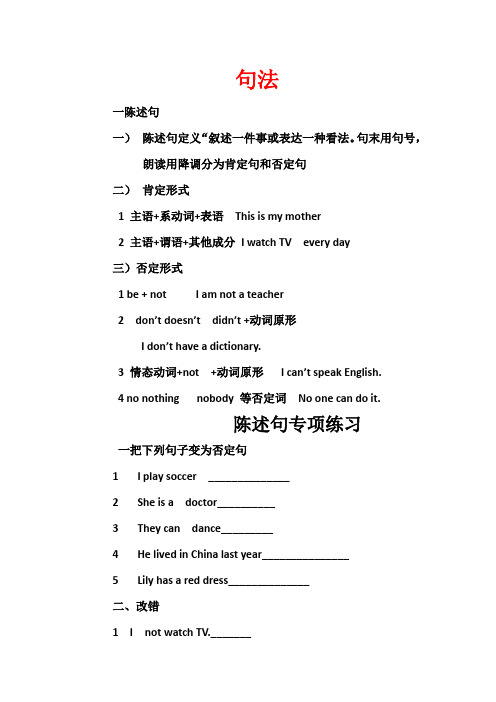
句法一陈述句一)陈述句定义“叙述一件事或表达一种看法。
句末用句号,朗读用降调分为肯定句和否定句二)肯定形式1 主语+系动词+表语This is my mother2 主语+谓语+其他成分I watch TV every day三)否定形式1 be + not I am not a teacher2 don’t doesn’t didn’t +动词原形I don’t have a dictionary.3 情态动词+not +动词原形I can’t speak English.4 no nothing nobody 等否定词No one can do it.陈述句专项练习一把下列句子变为否定句1I play soccer ______________2She is a doctor__________3They can dance_________4He lived in China last year_______________5Lily has a red dress______________二、改错1 I not watch TV._______2 She not can dance well_______3 I amn’t going to the park.4 It is don’t good_______5 Tom don’t go to school today _______三、连词成句1 brother fourteen is my ._____________2 sister his not can play football.________________________3 have don’t lunch I today._______________二疑问句一、疑问句定义:用来提问问题,询问情况的句子。
末尾用问号。
二、疑问句分类:一般疑问句、特殊疑问句、选择疑问句和反意疑问句。
人教版(PEP)小升初总复习语法之第三人称单数课件

3. 以辅音字母+y结 尾,把y变i再+es
I study English. He studies English.
4.一些比较特殊 的变化
I have four apples. He has four apples. have — has
1. Ben______ a new bike. A. have B. has C. are D. were
2. Kitty_____ her bike to school everyday. A. ride B. rides C. riding D. rode
3. How ______ it feel? A. does B. do C. are C.is
4. Jane and his mother _____happy. A. does B. do C. are D. is
5. Some apples ___a_r_e in the plate. 6. Milk _i_s__ my favorite drink.
1.动词原形+s I like apples.
He likes apples.
2.以s,x,ch,sh,o 结尾,+es
I teach him English. Mr. Wang teaches him English.
4.You always_____d_o___ (do) your homework well. 5.I____a_m_____ (be) ill. I'm staying in bed. 6.She_____g_o_e_s__ (go) to school from Monday to Friday. 7.Liu Tao ___d_o__e_s__ (do) not like PE. 8.The child often___w__a_t_c_h_e__s (watch) TV in the evening.
小升初英语语法复习要点归纳(PEP版)
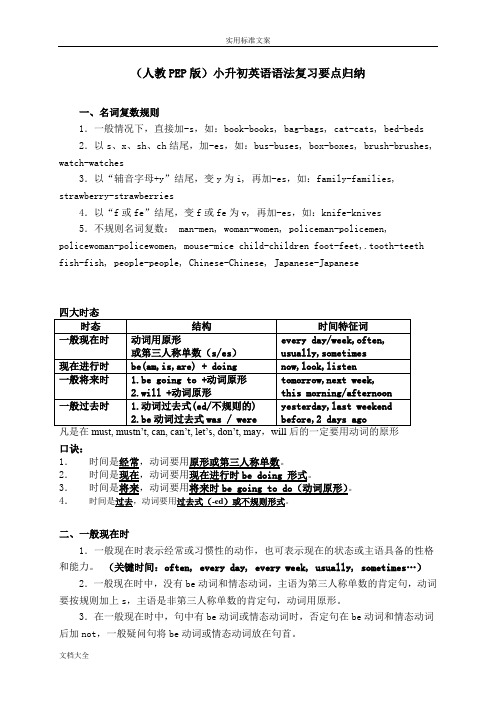
(人教PEP版)小升初英语语法复习要点归纳一、名词复数规则1.一般情况下,直接加-s,如:book-books, bag-bags, cat-cats, bed-beds 2.以s、x、sh、ch结尾,加-es,如:bus-buses, box-boxes, brush-brushes, watch-watches3.以“辅音字母+y”结尾,变y为i, 再加-es,如:family-families, strawberry-strawberries4.以“f或fe”结尾,变f或fe为v, 再加-es,如:knife-knives5.不规则名词复数: man-men, woman-women, policeman-policemen, policewoman-policewomen, mouse-mice child-children foot-feet,.tooth-teeth fish-fish, people-people, Chinese-Chinese, Japanese-Japanese口诀:1.时间是经常,动词要用原形或第三人称单数。
2.时间是现在,动词要用现在进行时be doing 形式。
3.时间是将来,动词要用将来时be going to do(动词原形)。
4.时间是过去,动词要用过去式(-ed)或不规则形式。
二、一般现在时1.一般现在时表示经常或习惯性的动作,也可表示现在的状态或主语具备的性格和能力。
(关键时间:often, every day, every week, usually, sometimes…)2.一般现在时中,没有be动词和情态动词,主语为第三人称单数的肯定句,动词要按规则加上s,主语是非第三人称单数的肯定句,动词用原形。
3.在一般现在时中,句中有be动词或情态动词时,否定句在be动词和情态动词后加not,一般疑问句将be动词或情态动词放在句首。
4.在一般现在时中,句中没有be动词或情态动词时,主语为第三人称单数的否定句在动词前加does+not (doesn’t),一般疑问句在句首加does,句子中原有动词用原形;主语为非第三人称单数,否定句用do+not (don’t),一般疑问句在句首加do,句子中动词用原形。
小升初语法祈使句(讲义)人教PEP版英语六年级下册

2024年小升初英语语法精讲精练祈使句一、定义:【考点精讲】表示命令、请求、警告或建议的句子。
【实战演练】判断下列句子是(T)否(F)是祈使句。
( )1. I get up at 7 o’clock every morning.( )2. Stand up!( )3. No photos.( )4. Don’t be late next time!( )5. He is reading books now.二、特点:【考点精讲】1.省略主语。
2.谓语动词用原型。
3.句末用句号或感叹号。
4.表示建议和请求时,常在句末(用逗号隔开)或句首加please, 使语气婉转。
Please open the door!= Open the door, please! 请打开门!【实战演练】选择题( )1. _________ me an email before you e to Hangzhou. I’ll meet you at the airport.A. SendingB. To sendC. SendsD. Send( )2. _________ talk in the reading room.A. Don’tB. NotC. NoD. No do( )3. _________ to smile at your life when you are in trouble, and you will soon be happy again.A. TryB. To try C.Trying D.Tried( )4. — _________ , or we’ll be late for the meeting.—It’s only half past one by my watch. We have enough time left.A. Hurry upB. Don’t worryC. Never mindD. Be quiet( )5. —Jack, don’t always copy what others do. _________ your head, please.—Thanks for telling me.A. UsingB. UsedC. UsesD. Use三、祈使句的两种类型【考点精讲】1). 以动词原形开头(用于省略第二人称主语的句子)。
最新原创PEP小升初英语语法大全(39页

名词一、可数名词与不可数名词的区别普通名词所表示的人或事物是可以按个数计算的,这类名词叫可数名词。
可数名词分为个体名词(表示某类人或事物中的个体,如worker, farmer, desk, factory等)和集体名词(表示作为一个整体来看的一群人或一些事物,如people,family 等)。
如果普通名词所表示的事物是不能按个数来计算的,这类名词就叫不可数名词。
不可数名词分为物质名词(表示无法分为个体的物质,如meat, rice, water, milk, orange 等)和抽象名词(表示动作、状态、情况、品质等抽象概念,如work, homework, time, health, friendship等)。
二、可数名词可数名词有单数和复数两种形式。
指一个人或一件事物时,用单数形式;指两个或多个人或事物时用复数形式。
名词由单数形式变成复数形式的规则如下:1. 一般的名词词尾直接加-s 。
如:book → books room → rooms house → houses day → days2. 以s,ss, ch,sh, x 结尾的名词,在词尾加-es 。
如:bus → buses glass → glasses watch → watches dish → dishes box → boxes3. 以"辅音字母+y"结尾的名词,要先将y改为i再加-es。
如:city → cities body → bodies factory → factories等等。
4. 以f 或fe 结尾的名词,要将f或fe改为v再加-es。
如:half → halves leaf → l eaves knife → knives wife → wives5. 特例[悄悄话:特例常常考,要记住。
]①child → children②man → men woman → women policeman → policemen policewoman-policewomen③tomato → tomatoes potato → potatoes [悄悄话:初中英语以o 结尾的名词变复数时只有这两个词加-es,其余的当然加-s喽!如:photo → photos ]④foo t → feet tooth → teeth [悄悄话:oo变成ee。
PEP小学英语小升初语法-单词总复习必备
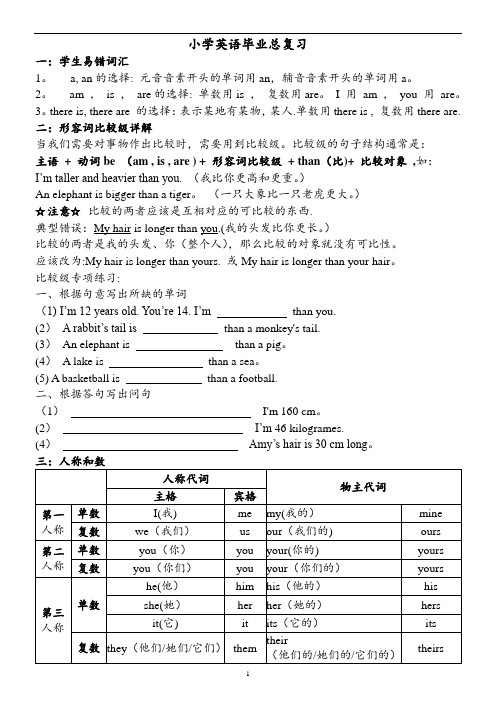
小学英语毕业总复习一:学生易错词汇1。
a, an的选择: 元音音素开头的单词用an,辅音音素开头的单词用a。
2。
am ,is ,are的选择: 单数用is ,复数用are。
I 用am ,you 用are。
3。
there is, there are 的选择:表示某地有某物,某人.单数用there is , 复数用there are. 二:形容词比较级详解当我们需要对事物作出比较时,需要用到比较级。
比较级的句子结构通常是:主语+ 动词be (am , is , are ) + 形容词比较级+ than(比)+ 比较对象,如:I’m taller and heavier than you. (我比你更高和更重。
)An elephant is bigger than a tiger。
(一只大象比一只老虎更大。
)☆注意☆比较的两者应该是互相对应的可比较的东西.典型错误:My hair is longer than you.(我的头发比你更长。
)比较的两者是我的头发、你(整个人),那么比较的对象就没有可比性。
应该改为:My hair is longer than yours. 或My hair is longer than your hair。
比较级专项练习:一、根据句意写出所缺的单词(1) I’m 12 years old. You’re 14. I’m than you.(2)A rabbit’s tail is than a monkey's tail.(3)An elephant is than a pig。
(4)A lake is than a sea。
(5) A basketball is than a football.二、根据答句写出问句(1)I'm 160 cm。
(2)I’m 46 kilogrames.(4)Amy’s hair is 30 cm long。
用所给词的适当形式填空1。
- 1、下载文档前请自行甄别文档内容的完整性,平台不提供额外的编辑、内容补充、找答案等附加服务。
- 2、"仅部分预览"的文档,不可在线预览部分如存在完整性等问题,可反馈申请退款(可完整预览的文档不适用该条件!)。
- 3、如文档侵犯您的权益,请联系客服反馈,我们会尽快为您处理(人工客服工作时间:9:00-18:30)。
实用文档文案大全PEP小学英语毕业总复习一:学生易错词汇1. a, an的选择: 元音字母开头的单词用an,辅音字母开头的单词用a.2. am , is , are的选择: 单数用is , 复数用are. I 用am , you 用 are.3. have , has 的选择: 表示某人有某物。
单数用has , 复数用have. I ,you 用 have .4. there is, there are 的选择:表示某地有某物,某人。
单数用there is , 复数用there are.5. some, any 的选择:肯定句用some, 疑问句和否定句用any.6. 疑问词的选择:what (什么) who (谁) where (哪里) whose (谁的) why(为什么)when(什么时候)which (哪一个)how old (多大) how many (多少)how much (多少钱)二:形容词比较级详解当我们需要对事物作出比较时,需要用到比较级。
比较级的句子结构通常是:什么 + 动词be (am , is , are ) + 形容词比较级 + than (比)+ 什么 ,如:I'm taller and heavier than you. (我比你更高和更重。
)An elephant is bigger than a tiger. (一只大象比一只老虎更大。
)形容词的比较级是在形容词的基础上变化而来的,它的变化规则是:①一般的直接在词尾加er ,如 tall - taller , strong - stronger ,②以e结尾的,直接加r ,如 fine – finer ,③以辅音字母加y结尾的,先改y为i再加er,如funny - funnier ④双写最后的字母再加er,如big – bigger, thin – thinner ,hot – hotter ☆注意☆比较的两者应该是互相对应的可比较的东西。
典型错误:My hair is longer than you.(我的头发比你更长。
)比较的两者是我的头发、你(整个人),那么比较的对象就没有可比性。
应该改为:My hair is longer than yours. 或My hair is longer than your hair.比较级专项练习: 一、从方框中选出合适的单词完成句子heavy tall long big(1) How is the Yellow River?(2) How is Mr Green? He's175cm.(3) How are your feet? I wearsize 18. (4)How is the fish?It's 2kg.二、根据句意写出所缺的单词(1) I'm 12 years old. You're 14. I'mthan you. (2) A rabbit's tail isthan a monkey's tail.(3) An elephant isthan a pig. (4) A lake isthan a sea.(5) A basketball is thana football.实用文档文案大全三、根据中文完成句子.(1) 我比我的弟弟大三岁. I'mthan my brother.(2) 这棵树要比那棵树高. This treethan that one. (3) 你比他矮四厘米.You are than he.(4) 谁比你重?than you?四、根据答句写出问句(1)I'm 160 cm.(2)I'm 12 years old.(4)Amy's hair is 30 cm long.四:动词现在分词详解动词的ing形式的构成规则:①一般的直接在后面加上ing , 如doing , going , working , singing , eating②以e 结尾的动词,要先去e再加ing,如having , writing③双写最后一个字母的(此类动词极少)有:running , swimming , sitting , getting五:人称和数六:句型专项归类1、肯定句:是指用肯定的语气来陈述的句子,如:I'm a student. She is a doctor.He works in a hospital.There are four fans in our classroom. He will eat lunch at 12:00. I watched TV yesterday evening.2、否定句:含有否定词或表示否定意义词的句子,如:I'm nota student. She is实用文档文案大全not (isn't) a doctor.He does not (doesn't) work in a hospital. There are not (aren't) four fans in our classroom. He will not (won't) eat lunch at 12:00. I did not (didn't) watch TV yesterday evening.☆注意☆小结:否定句主要是在肯定句的基础上加上了否定词“not”。
有动词be的句子则“not”加在be后面,可缩写成“isn't,aren't”,但am not 一般都分开写。
没有动词be的句子则要先在主要动词的前面加上一个助动词(do,does,did),然后在它后面加上“not”,你也可以把它们缩写在一起如“don't , doesn't , didn't )。
这三个助动词要根据人称和时态来选择,其中“does”只用于一般现在时主语是第三人称单数的情况,而“did”只用于一般过去时,不论主语是什么人称和数,都用“did”。
3、一般疑问句:是指询问事实的句子,此类句子必须用“yes”,或“no”来回答。
如:Are you a student? Yes, I am / No, I'm not.Is she a doctor? Yes, she is. / No, she is n't. Does he work in a hospital? Yes, he does. / No,he does n't.Are there four fans in our classroom? Yes, there are. / No, there are n't.Are you going to buy a comic book tonight? Yes, I am. / No, I am not. (Yes, we are. / No, we are n't.) Will he eat lunch at 12:00? Yes, I will. / No, I will not(won't).Are they swimming? Yes, they are. / No, they are n't. Did you watch TV yesterday evening? Yes, I did. / No, I did n't.☆注意☆小结:一般疑问句是在肯定句的基础上,①把动词be调到首位,其他照写,末尾标点符号变成问号即可。
②没有动词be的句子则要在句首加上一个助动词(do,does,did)再把紧跟在后面的动词变回原形,末尾标点符号变成问号即可。
这三个助动词也要根据人称和时态来选择,其中“does”只用于一般现在时主语是第三人称单数的情况,而“did”只用于一般过去时,不论主语是什么人称和数,都用“did”。
一般疑问句有个重要的原则就是问和答要一致,即问句里的第一个单词(助动词)和简略答句里的这个词是一致的。
4、特殊疑问句:以特殊疑问词(what , where , who , which , when , whose , why , how等)开头引导的句子。
此类句子应该问什么就答什么,不能用“yes 、no”来回答。
如:What is this? It's a computer.What does he do? He's a doctor.Where are you going? I'm going to Beijing. Who played football with you yesterday afternoon? Mike.Which season do you like best? Summer.When do you usually get up? I usually get up at 6:30.实用文档文案大全Whose skirt is this? It's Amy's.Why do you like spring best? Because I can plant trees.How are you? I'm fine. / I'm happy.How did you go to Xinjiang? I went to Xinjiang by train.☆其中how又可以和其他一些形容词连用组成特殊疑问词组用来提问,如: how many(多少(数量)), how much(多少(钱)), how tall(多高), how long(多长), how big (多大), how heavy(多重)例句:How many pencils do you have? I have three pencils.How many girls can you see? I can see four girls. How many desks are there in your classroom? There are 51.☆小结:how many 用来提问可数名词的数量,主要有以上三种句式搭配,How many + 名词复数 + do you have? 你有多少……?How many + 名词复数+ can you see? 你能看见多少……?How many + 名词复数+ are there…? 有多少……?七:完全、缩略形式: I'm=I am he's=he is she's=she is they're=they areyou're=you are there's=there is they're=they are can't=can not don't=do notdoesn't=does not isn't=is not aren't=are not let's=let us won't=will not I'll=I will wasn't=was not总结:通常情况下,'m即am,'s即is(但 let's=let us),'re即are ,n't即not (但can't=can not)八:与字母相关的题型 ( 注:五个元音字母是 Aa Ee Ii Oo Uu ) 一.将所给字母的大小写写在四线格上二.写出下列字母的左邻右舍。
